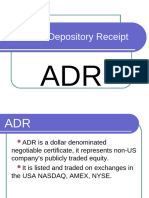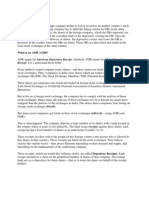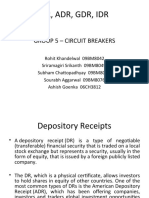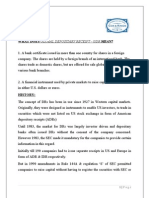GDR & ADR
GDR & ADR
Uploaded by
kajalgaikwad692Copyright:
Available Formats
GDR & ADR
GDR & ADR
Uploaded by
kajalgaikwad692Copyright
Available Formats
Share this document
Did you find this document useful?
Is this content inappropriate?
Copyright:
Available Formats
GDR & ADR
GDR & ADR
Uploaded by
kajalgaikwad692Copyright:
Available Formats
Depository Receipts
A depositary receipt (DR) is a negotiable certificate representing shares
in a foreign company traded on a local stock exchange.
Depositary receipts allow investors to hold equity shares of foreign
companies without the need to trade directly on a foreign market.
Depositary receipts allow investors to diversify their portfolios by
purchasing shares of companies in different markets and economies.
Depositary receipts are more convenient and less expensive than
purchasing stocks directly in foreign markets.
Instead of individual investor approaching the foreign equity market, the
investor’s money is collected by an institution or bank called as Depository.
The Depository Bank would evaluate & complete the legal requirement and
would buy equity shares of the foreign firms. Equity shares would be held by
the depository and receipts will be given to the investors. This Depository
receipt spelt out the claim on the benefits of equity shares held by the
depository. Hence, all the benefits of dividend, bonus shares etc. are passed on
the investors by depository in proportion to their investment.
GDR (Global Depository Receipts)
A GDR is a negotiable instrument issued by a depository bank in international
markets. This receipt represents ownership of shares in a non-US company,
enabling the company (i.e.) to access investors in capital markets outside its
home country.
Each GDR represents a specific number of underlying ordinary shares in the
international company. A GDR can be denominated in any freely convertible
currency.
Features
1) GDR’s are issued to investors in more than one country.
2) GDR’s are issued to investors by the depository bank and not the issuing
company. This means that in the books of issuing company, the
depository bank appears as the shareholder. GDR holders, therefore,
does not have voting rights. The voting rights accrue only to the
depository bank.
3) The proceeds are collected in foreign currency thus, enabling the issues
to utilise the same for meeting the forex component project cost,
repayment of foreign currency loans, meeting overseas commitments
and for similar other purposes.
4) An investor who wants to cancel his GDR may do so by advising the
depository to request the Custodian. The GDR can be cancelled only
after a cooling period of 45 days. The Depository will instruct custodian
about cancellation of the GDR and to release the corresponding shares,
collect the sales proceeds and remit the same abroad.
5) An investor can sell GDR’s as is on the proper exchanges, or the investor
can convert them into regular stock for the company.
6) GDR holders are entitled to all corporate benefits available to equity
holders such as dividend, bonus and rights in the same proportions as
their entitlement. GRS’s and their dividends are priced in the local
currency of the exchanges where the shares are traded.
7) Indian companies that have a solid financial record of about three years
are readily allowed access to global financial markets through the use of
a GDR. However, clearances are required from the Foreign Investment
Promotion Board (FIPB) and the Ministry of Finance.
Mechanism of GDR
1) The domestic company wishing to issue equity shares favouring
international investors is called “The Issuing Company”. It enters into an
agreement with an international investment bank to act as the
depository bank. The agreement generally called the depository
agreement specifies the right and obligations of the parties and the
terms of the GDR issue. Normally through this agreement, the
depository bank waives its voting rights in favour of the management.
This mitigates the risk of losing management control.
2) The issuing company appoints an international merchant bank to act as
“Lead Manager”. The lead manager is required to market the issue to
international investors by conducting ‘Road Shows ”. These road shows
are seminar or work – shops held for educating investors about the
background, financial status and future prospectus of issuing company.
3) After such road shows the lead manager arranges ‘book runners’ who
are specialized agencies for establishing and analysing investor response
to the issue. The purpose of this analysis is to help the issuing company
to price the issue at an appropriate level.
4) After the issue price is decided, the lead manager collects subscription
money form potential investors and after deducting their fees transfers
the collected amount to the depository bank.
5) The proceeds of the GDR issues are held by the depository bank on
behalf of the issuing company.
6) The issuing company now issues physical shares in favour of the
depository bank and submits then to a domestic bank in the country of
the issuing company which acts as an agent of the depository bank.
7) This domestic bank keeping custody of the underlying shares pertaining
to the GDR issue is called ‘Custodian Bank’. This bank is appointed by the
depository bank which pays all the fees of the custodian bank.
8) On receiving confirmation from the custodian bank regarding receipt of
the underlying equity shares, the depository bank issues GDR’s to the
successful applicants to the issue.
9) The issuing company now helps the depository bank to arrange listing of
the GDR’s. Most of Indian companies list the GDR’s on the international
stock exchanges in London and Luxumberg. This helps investors to freely
trade in GDR’s. The depository bank now also appoints an international
clearing system which operates like a registrar and transfer agent cum
depository. The clearing system maintains up to date information data
base of GDR holders. Distribution of all corporate benefits is done by the
Custodian bank on behalf of the depository in co-ordination with the
clearing system.
American Depository Receipt
American Depositary Receipts (ADR) are negotiable security
instruments that are issued by a US bank that represent a specific
number of shares in a foreign company that is traded in US financial
markets. ADRs pay dividends in US dollars and trade like regular
shares of stock. Companies can now purchase stocks of foreign
companies in bulk and reissue them on the US market. ADRs are
listed on the NYSE, NASDAQ, AMEX and can be sold over-the-
counter.
Types of American Depositary Receipts
The ADRs that are sold in US financial markets can be categorized
into sponsored and unsponsored.
1. Sponsored ADR
For a sponsored ADR, the foreign company issuing shares to the
public enters into an agreement with a US depositary bank to sell
its shares in US markets. The US bank is responsible for
recordkeeping, sale, and distribution of shares to the public,
distribution of dividends, etc. Sponsored ADRs can be listed on
the US stock exchanges.
2. Non-Sponsored ADR
A non-sponsored ADR is created by brokers/dealers without the
cooperation of the foreign company issuing the shares. Non-
sponsored ADRs are traded in US over-the-counter markets
without requiring registration with the Securities and Exchange
Commission (SEC).
Before 2008, any brokers and dealers trading in ADRs were
required to submit a written application before being allowed to
trade in the US. The 2008 SEC amendment provided an
exemption to foreign issuers that met certain regulatory
conditions. Non-sponsored ADRs are only traded on over-the-
counter markets.
Levels of American Depositary Receipts
ADRs are grouped into three levels depending on the extent of
the foreign company’s access to the US trading market.
1. Sponsored Level I
Level I is the lowest level at which sponsored ADRs can be issued.
It is the most common level for foreign companies that do not
qualify for other levels or that do not want their securities listed
on US exchanges. Level I ADRs are subject to the least reporting
requirements with the Securities and Exchange Commission, and
they are only traded over the counter.
The companies are not required to issue quarterly or annual
reports like other publicly traded companies. However, Level I
issuers must have their stock listed on one or more exchanges in
the country of origin. Level I can be upgraded to Level II when the
company is ready to sell through US exchanges.
2. Sponsored Level II ADRs
Level II ADRs have more requirements from the SEC than Level I,
and the company gets an opportunity to establish a higher
trading presence on the US stock markets. The company must file
a registration statement with the SEC.
Also, the company must file Form-20-F in accordance with the
GAAP or IFRS standards. Form 20-F is the equivalent of Form-10-
K, which is submitted by US publicly traded companies. If the
issuer fails to comply with these requirements, it may be delisted
or downgraded to Level I.
3. Sponsored Level III ADRs
Level III is the highest and most prestigious level that a foreign
company can sponsor. A foreign company at this level can float a
public offering of ADRs to raise capital from American investors
through US exchanges. Level III ADRs also attract stricter
regulations from the SEC.
The company must file Form F-1 (prospectus) and Form 20-F
(annual reports) in accordance with GAAP or IFRS standards. Any
materials distributed to shareholders in the issuer’s home country
must be submitted to the SEC as Form 6-K.
Examples of foreign companies that have managed to enter this
ADR level include Vodafone, Petrobras, and China Information
Technology.
You might also like
- 108 Questions & Answers On Mutu - Yadnya InvestmentsDocument202 pages108 Questions & Answers On Mutu - Yadnya Investmentsk praNo ratings yet
- Income Tax 2Document27 pagesIncome Tax 2Mohammad AnikNo ratings yet
- Test Bank Accounting 25th Editon Warren Chapter 17 Financial Statement AnalysisDocument126 pagesTest Bank Accounting 25th Editon Warren Chapter 17 Financial Statement AnalysisJessa De GuzmanNo ratings yet
- PracticeDocument5 pagesPracticearif khanNo ratings yet
- Unit II - American Depository Receipt (ADR)Document142 pagesUnit II - American Depository Receipt (ADR)satheeshkumarsayoojNo ratings yet
- If (3,4,5)Document8 pagesIf (3,4,5)gopika premarajanNo ratings yet
- Ways To Raise Finance From International MarketDocument7 pagesWays To Raise Finance From International Marketankitonway100% (1)
- Market For Depository ReceiptsDocument16 pagesMarket For Depository ReceiptsShivangi MahajanNo ratings yet
- ProjectDocument30 pagesProjectSunilPandeyNo ratings yet
- Adr GDR IdrDocument19 pagesAdr GDR IdrRachit MadhukarNo ratings yet
- Untitled DocumentDocument2 pagesUntitled DocumentHemraj DhobleNo ratings yet
- PPTDocument17 pagesPPTSwati SabharwalNo ratings yet
- ADR and GDRDocument22 pagesADR and GDRsaini_randeep2No ratings yet
- Depository Receipts PrimerDocument5 pagesDepository Receipts PrimerAstrologer GuruNo ratings yet
- AdrDocument38 pagesAdrMatthew HickmanNo ratings yet
- Unit-6 International Sources of FinanceDocument12 pagesUnit-6 International Sources of FinanceShefali TailorNo ratings yet
- Adr, GDR and EcgcDocument12 pagesAdr, GDR and EcgcRaghu Veera SaikumarNo ratings yet
- Presentation On ADR GDR and FCCB - 27.02.09Document29 pagesPresentation On ADR GDR and FCCB - 27.02.09darshan22No ratings yet
- Unit 3Document12 pagesUnit 3Davra NevilNo ratings yet
- What Is Euro Issue?Document22 pagesWhat Is Euro Issue?Jay PandyaNo ratings yet
- How Do Drs Work?: Receipt. Let'S Understand These BetterDocument5 pagesHow Do Drs Work?: Receipt. Let'S Understand These Bettertp4fNo ratings yet
- Adrs and GDRS: Similarities and Benefits - Financial ManagementDocument5 pagesAdrs and GDRS: Similarities and Benefits - Financial ManagementvikasNo ratings yet
- International Banking and Foreign Exchange ManagementDocument7 pagesInternational Banking and Foreign Exchange ManagementSolve AssignmentNo ratings yet
- Chapter 3Document21 pagesChapter 3Manjunath BVNo ratings yet
- FR NotesDocument8 pagesFR NotesChhandogya PatilNo ratings yet
- Forex Capital and Eurocurrency MarketDocument35 pagesForex Capital and Eurocurrency MarketNirav TannaNo ratings yet
- SMO Unit-Iv Adr, Fdi, GDR, Fii, Euro IssueDocument6 pagesSMO Unit-Iv Adr, Fdi, GDR, Fii, Euro IssueSANGITA ACHARYANo ratings yet
- Report On Adr GDR N IdrDocument9 pagesReport On Adr GDR N IdrManaswee Sahoo100% (1)
- International Swaps and Derivatives Association (ISDA)Document5 pagesInternational Swaps and Derivatives Association (ISDA)Anonymous f5qGAcZYNo ratings yet
- American Depositary ReceiptDocument7 pagesAmerican Depositary ReceiptarmailgmNo ratings yet
- Financing International OperationsDocument16 pagesFinancing International OperationsVikash ShawNo ratings yet
- Adr, GDR, and IdrDocument30 pagesAdr, GDR, and IdrMaheshMuraleedharanNo ratings yet
- FDI FII & International Finance ExamplesDocument21 pagesFDI FII & International Finance ExamplesgauravNo ratings yet
- How ADRs WorkDocument9 pagesHow ADRs WorkPallavi WaghNo ratings yet
- SAPM - Notes-1 PDFDocument9 pagesSAPM - Notes-1 PDFSanjay YadavNo ratings yet
- Sources of International FinancingDocument6 pagesSources of International FinancingSabha Pathy100% (2)
- Long Term Source of FundsDocument2 pagesLong Term Source of FundsSerafica, Margotte AllyzaNo ratings yet
- Global Markets: Topic: ADR's, GDR's & FCCB'sDocument10 pagesGlobal Markets: Topic: ADR's, GDR's & FCCB'sRachna JayaraghavNo ratings yet
- Adrsgdrsfdipptfinal 120827124149 Phpapp02Document29 pagesAdrsgdrsfdipptfinal 120827124149 Phpapp02Chidam BaramNo ratings yet
- Question 1Document5 pagesQuestion 1Harpal Singh MassanNo ratings yet
- DEC 2022 - International FinanceDocument10 pagesDEC 2022 - International FinanceindrakumarNo ratings yet
- American Depository ReceiptsDocument38 pagesAmerican Depository ReceiptsD Attitude KidNo ratings yet
- Adr GDRDocument28 pagesAdr GDRAnupam JyotiNo ratings yet
- DR, Adr, GDR, Idr: Group 5 - Circuit BreakersDocument16 pagesDR, Adr, GDR, Idr: Group 5 - Circuit BreakersSaurabh Gupta100% (1)
- Guidelines For ADR Issues by The Indian CompaniesDocument6 pagesGuidelines For ADR Issues by The Indian CompaniesManindra BharadwajNo ratings yet
- Foreign Institutional Investors and Depository ReceiptsDocument45 pagesForeign Institutional Investors and Depository Receiptssunitha2No ratings yet
- Depositary ReceiptsDocument40 pagesDepositary Receiptsapeksha_6065320560% (1)
- Comparative Investment LawDocument11 pagesComparative Investment LawRishikant DashNo ratings yet
- International Source of Finance: Empi Business School, New DelhiDocument28 pagesInternational Source of Finance: Empi Business School, New DelhiVikram MandalNo ratings yet
- Securities LawDocument10 pagesSecurities LawKonnoju ShivasreeNo ratings yet
- Adr GDRDocument7 pagesAdr GDRAnand SinghNo ratings yet
- GDR of Cox N KingsDocument80 pagesGDR of Cox N KingsMinal AgrawalNo ratings yet
- Adr and GDR: by Prof. Augustin AmaldasDocument15 pagesAdr and GDR: by Prof. Augustin Amaldasrohan jhaNo ratings yet
- Euro Issues & GdrsDocument25 pagesEuro Issues & Gdrsvred4uNo ratings yet
- Adr and GDR NotesDocument3 pagesAdr and GDR NotesMAGESH KUMARNo ratings yet
- ADR, GDR, IDRDocument20 pagesADR, GDR, IDRvijishmaNo ratings yet
- Presentation On GDR Issue JHSDJW G DWGDBW dwgd7wbdw Wuid Nfvwyd Wndbwygw2bdn FHWDocument22 pagesPresentation On GDR Issue JHSDJW G DWGDBW dwgd7wbdw Wuid Nfvwyd Wndbwygw2bdn FHWHimanshu JaiswalNo ratings yet
- Project Work On Capital Market Instruments: Submitted BY Ankit Agrawal 4 BBM D 1011331Document9 pagesProject Work On Capital Market Instruments: Submitted BY Ankit Agrawal 4 BBM D 1011331Savinder SachdevNo ratings yet
- ADR Issue ProcessDocument2 pagesADR Issue ProcessAishwarya RamakrishnaNo ratings yet
- Hemant Sachan - IFMDocument12 pagesHemant Sachan - IFMHemant SachanNo ratings yet
- Financial MarketDocument29 pagesFinancial Marketsantosh kumar mauryaNo ratings yet
- capital structure PlanningDocument55 pagescapital structure Planningkajalgaikwad692No ratings yet
- international credit rating agenciesDocument7 pagesinternational credit rating agencieskajalgaikwad692No ratings yet
- International financeDocument23 pagesInternational financekajalgaikwad692No ratings yet
- STP ProgramDocument1 pageSTP Programkajalgaikwad692No ratings yet
- case study 1Document3 pagescase study 1kajalgaikwad692No ratings yet
- HRM Unit no 1 (2021)Document80 pagesHRM Unit no 1 (2021)kajalgaikwad692No ratings yet
- Case Study 3Document3 pagesCase Study 3kajalgaikwad692No ratings yet
- Unit 1. Indian Financial System 2Document18 pagesUnit 1. Indian Financial System 2kajalgaikwad692No ratings yet
- Acctg. Equation Puring CompanyDocument8 pagesAcctg. Equation Puring CompanyAngelNo ratings yet
- Q RV 57 W Vjed KW RRBM 2 ZCCDocument66 pagesQ RV 57 W Vjed KW RRBM 2 ZCCsaroj rajavariNo ratings yet
- Ebl Annual Report 2022Document396 pagesEbl Annual Report 2022rashed.hassan20021No ratings yet
- UNIT 2 Company LawDocument34 pagesUNIT 2 Company Lawathought60No ratings yet
- Cambridge IGCSE: ACCOUNTING 0452/22Document20 pagesCambridge IGCSE: ACCOUNTING 0452/22meizhu1440No ratings yet
- Vertoz AdvertisDocument49 pagesVertoz AdvertisRamesh ReddyNo ratings yet
- Journal of International Accounting, Auditing and Taxation: Mattias Hamberg, Leif-Atle BeislandDocument15 pagesJournal of International Accounting, Auditing and Taxation: Mattias Hamberg, Leif-Atle BeislandAndry YadisaputraNo ratings yet
- Module 6 - Corporate ValuationDocument7 pagesModule 6 - Corporate ValuationushaNo ratings yet
- Diamond Eagle Acquisition Corporation S-4Document15 pagesDiamond Eagle Acquisition Corporation S-4Carlos JesenaNo ratings yet
- Maruti Suzuki India LTD.: Balance Sheet (Standalone)Document5 pagesMaruti Suzuki India LTD.: Balance Sheet (Standalone)Denish VekariyaNo ratings yet
- C Ons TR Uc Ted Res Ponse Questions - Section C: S E Cti On 3Document2 pagesC Ons TR Uc Ted Res Ponse Questions - Section C: S E Cti On 3Mazni Hanisah100% (1)
- Financial Modelling PDFDocument5 pagesFinancial Modelling PDFPuneet MalhotraNo ratings yet
- VW ODP AgreementDocument2 pagesVW ODP Agreementterresaturner69No ratings yet
- Investments (Theories)Document41 pagesInvestments (Theories)Iris Mnemosyne100% (1)
- Choice Between Debt and Equity and Its Impact On Business PerformanceDocument13 pagesChoice Between Debt and Equity and Its Impact On Business PerformanceAvinash aviNo ratings yet
- Ship Invesment - Muara JayaDocument1,037 pagesShip Invesment - Muara JayaGiovani Lintang100% (1)
- Quarterly Income Tax Return For Corporations, Partnerships and Other Non-Individual TaxpayersDocument2 pagesQuarterly Income Tax Return For Corporations, Partnerships and Other Non-Individual TaxpayersRegs AccountingTaxNo ratings yet
- Joseph L. Rice LP Announcement LetterDocument1 pageJoseph L. Rice LP Announcement LetterDealBookNo ratings yet
- Mock Exam 5 QuesDocument52 pagesMock Exam 5 QuesEduardo LeonNo ratings yet
- ACCOUNTING March 2024 GRADE 12 MG-1Document7 pagesACCOUNTING March 2024 GRADE 12 MG-1mthalaneamanda9No ratings yet
- Traditional Models of Financial Statements AnalysisDocument4 pagesTraditional Models of Financial Statements AnalysisMary LeeNo ratings yet
- wk5 Act Fabm2Document2 pageswk5 Act Fabm2loismyrelopezNo ratings yet
- Mcqs 22 Ratio Analysis and NpaDocument3 pagesMcqs 22 Ratio Analysis and Npaomvir singhNo ratings yet
- Neha Old StatementDocument2 pagesNeha Old Statementshreejee.1527No ratings yet
- Fund Flow Statement-FR FSADocument27 pagesFund Flow Statement-FR FSADãrk LïghtNo ratings yet
- Leverage AnalysisDocument6 pagesLeverage AnalysisJoshua CabinasNo ratings yet

































































































